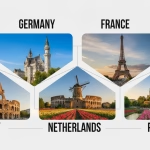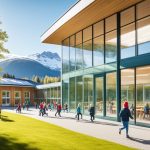Did you know that the Nordic countries consistently rank among the top in global education rankings? These countries, including Denmark, Finland, Iceland, Norway, and Sweden, have crafted an education system that is praised for its high quality, innovation, and inclusivity. For global learners seeking exceptional educational experiences, the education system in the Nordic countries holds immense promise.
Key Takeaways:
- The education system in the Nordic countries consistently ranks among the top globally.
- Denmark, Finland, Iceland, Norway, and Sweden are admired for their high-quality and innovative educational approaches.
- Global learners can benefit from the inclusive and multicultural learning environments offered by Nordic educational institutions.
- Studying in the Nordic countries provides access to free education options, high-quality teaching, and a focus on sustainability and innovation.
- The education system in the Nordic countries prepares students for the future by emphasizing practical skills, international perspectives, and personal growth.
Overview of the Nordic Education System
The Nordic education system is renowned worldwide for its exceptional quality and innovative approach to learning. With a focus on inclusivity, practicality, and holistic development, the education systems in the Nordic countries provide students with a solid foundation for success.
Key Characteristics
The Nordic Education System boasts several key characteristics that set it apart from other educational systems:
- Equal Opportunities: The Nordic countries prioritize equal opportunities for all students, ensuring that every child has access to high-quality education regardless of their background or circumstances.
- Child-Centered Approach: In the Nordic countries, education is designed to cater to the individual needs and interests of each student, fostering a love for learning from an early age and allowing students to develop at their own pace.
- Collaborative Learning: Collaboration is an integral part of the Nordic education system, with students encouraged to work together on projects and problem-solving activities, promoting teamwork, communication, and critical thinking skills.
- Multilingualism: In addition to their native languages, students in the Nordic countries are often exposed to multiple languages from an early age, facilitating cross-cultural communication and global understanding.
- Practical Skills: The Nordic education system emphasizes the development of practical skills alongside academic knowledge, preparing students for real-world challenges and equipping them with the tools needed for future success.
Structures in the Nordic Education System
The Nordic education system consists of various levels of education, each playing a crucial role in a student’s academic journey:
- Early Childhood Education: Early childhood education in the Nordic countries focuses on developing social, emotional, and cognitive skills in young children, setting a strong foundation for future learning.
- Primary Education: Primary education typically starts at the age of six or seven and provides a comprehensive curriculum that includes core subjects, art, physical education, and foreign languages.
- Secondary Education: Following primary education, students enter secondary education, where they have the option to choose between academic or vocational tracks. Both tracks provide a well-rounded education and prepare students for higher education or the workforce.
- Vocational Education and Training: Vocational education and training programs offer practical and hands-on learning opportunities, equipping students with skills relevant to specific industries and professions.
- Higher Education: The Nordic countries are home to prestigious universities and institutions that offer a wide range of bachelor’s, master’s, and doctoral programs, attracting students from around the world.
The Nordic education system is renowned worldwide for its exceptional quality and innovative approach to learning. With a focus on inclusivity, practicality, and holistic development, the education systems in the Nordic countries provide students with a solid foundation for success.
Primary Education in the Nordic Countries
When it comes to primary education, the Nordic countries have established a reputation for their inclusive and child-centered approach to learning. They prioritize the holistic development of young learners by providing an environment that fosters creativity, curiosity, and collaboration.
The primary education system in the Nordic countries places a strong emphasis on individualized learning, aiming to meet the unique needs and abilities of each student. This approach ensures that children can progress at their own pace and explore their interests while receiving the necessary support and guidance from qualified educators.
One of the distinctive features of primary education in the Nordic countries is the focus on play-based learning. They recognize the importance of play in a child’s development and incorporate it into the curriculum to enhance cognitive, social, and emotional skills. Through play, children acquire problem-solving abilities, develop communication skills, and learn to collaborate with their peers.
The Nordic countries also prioritize outdoor education, taking advantage of their natural surroundings to provide hands-on experiences for students. Forest schools, for example, are common in these countries, where students spend time learning and exploring nature. This approach not only enhances their understanding of the environment but also promotes physical activity and overall well-being.
Inclusive education is another key aspect of primary education in the Nordic countries. They strive to create an inclusive and supportive learning environment where students with diverse backgrounds and abilities can thrive. Collaborative learning methods and individualized support ensure that every child receives the attention and resources they need to succeed.
The Role of Teachers in Primary Education
Teachers in primary education play a crucial role in implementing the child-centered approach and creating a nurturing environment. They act as facilitators, guiding students through their learning journey and encouraging critical thinking, creativity, and problem-solving skills.
In addition to their academic responsibilities, teachers in the Nordic countries focus on fostering students’ social and emotional development. They promote a positive classroom atmosphere, teaching children to respect one another, embrace diversity, and develop empathy towards others.
Continuous professional development is also highly valued in the Nordic countries’ primary education system. Teachers engage in regular training and workshops to enhance their teaching practices, stay updated on the latest research, and continuously improve their pedagogical skills.
With a strong emphasis on child-centered learning, inclusivity, and the professional development of educators, the primary education system in the Nordic countries ensures that children receive a solid foundation for their future academic and personal growth.
Key Features of Primary Education in the Nordic Countries
| Key Features | Description |
|---|---|
| Child-Centered Learning | A focus on meeting the unique needs and abilities of each student, progressing at their own pace. |
| Play-Based Learning | Incorporating play into the curriculum to enhance cognitive, social, and emotional skills. |
| Outdoor Education | Utilizing natural surroundings for hands-on experiences and promoting physical activity. |
| Inclusive Education | Creating a supportive learning environment where students with diverse backgrounds and abilities thrive. |
| Teachers’ Role | Facilitating learning, promoting social and emotional development, and continuous professional development. |
Secondary Education in the Nordic Countries
Secondary education in the Nordic countries is designed to provide students with a holistic development approach, preparing them for a wide range of future opportunities. With a strong focus on academic excellence, personal growth, and practical skills, the secondary education system in the Nordic countries offers a comprehensive and well-rounded educational experience.
Students in the Nordic countries typically begin secondary education between the ages of 15 and 16, after completing their primary education. Secondary schools in these countries aim to create a supportive and inclusive learning environment that encourages students to explore their interests and talents.
Curriculum and Subjects
The secondary education curriculum in the Nordic countries is broad and diverse, offering a wide range of subjects for students to choose from. While core subjects such as mathematics, languages, and sciences are compulsory, students also have the opportunity to specialize in specific areas of interest.
Additionally, secondary education in the Nordic countries places a strong emphasis on extracurricular activities, encouraging students to participate in sports, arts, and community service. These activities foster social skills, teamwork, and leadership abilities, enhancing students’ personal growth and overall development.
Educational Philosophy
The educational philosophy in the Nordic countries seeks to nurture students’ autonomy, critical thinking, and creativity. Teachers encourage active engagement and independent learning, promoting a student-centered approach that empowers learners to take ownership of their education.
Secondary education in the Nordic countries emphasizes the development of well-rounded individuals who are equipped with the skills needed to succeed in an ever-changing world. It fosters a love of learning, critical thinking, and a strong sense of social responsibility.
Secondary Education Comparison
| Aspect | Nordic Countries | Traditional Education Systems |
|---|---|---|
| Curriculum | Diverse and flexible curriculum, focusing on both core subjects and specialization. | Often rigid and standardized curriculum, with limited subject choices. |
| Extracurricular Activities | Strong emphasis on extracurricular activities, promoting personal growth and social skills. | Varies; extracurricular activities may be limited or not prioritized. |
| Educational Philosophy | Student-centered approach, fostering independent learning and critical thinking. | Teacher-centric approach, focusing on knowledge transmission. |
Vocational Education and Training in the Nordic Countries
When it comes to vocational education and training, the Nordic countries are at the forefront of providing students with practical skills and preparing them for the workforce. With a strong focus on hands-on learning and industry-relevant curriculum, vocational education in the Nordic countries equips learners with the necessary knowledge and abilities to excel in their chosen careers.
One of the key advantages of vocational education in the Nordic countries is its close alignment with the needs of the job market. The vocational programs offered are designed in collaboration with employers and industry experts to ensure that students acquire the skills and competencies demanded by the market. This approach not only increases employability but also helps address skill gaps and shortages within various sectors.
Whether you’re interested in pursuing a career in construction, healthcare, technology, or hospitality, the Nordic countries offer a wide range of vocational training options to suit diverse interests and aspirations. Let’s take a closer look at some of the popular vocational education pathways in the region:
1. Vocational Schools
Vocational schools in the Nordic countries provide comprehensive training programs that combine theoretical knowledge with practical hands-on experience. These schools offer specialized courses in various trades and professions, allowing students to gain expertise in their chosen field. From electricians to chefs, automotive technicians to hairdressers, vocational schools cater to a wide range of vocational interests.
2. Apprenticeships
In addition to vocational schools, apprenticeship programs play a significant role in vocational training in the Nordic countries. Students have the opportunity to work directly with experienced professionals in their preferred industry, honing their skills through practical on-the-job training. Apprenticeships provide valuable real-world experience and often lead to job opportunities within the same organization or industry.
3. Dual Education Systems
The Nordic countries also embrace the concept of dual education, combining classroom-based learning with on-the-job training. This approach allows students to gain practical experience while simultaneously studying the theoretical aspects of their chosen profession. Dual education systems are highly regarded for their ability to produce well-rounded and job-ready graduates.
Overall, the vocational education and training options available in the Nordic countries offer students a pathway to meaningful and fulfilling careers. These programs equip learners with the skills, knowledge, and practical experience required to excel in the ever-evolving job market. By prioritizing industry relevance and collaboration with employers, the Nordic countries have established themselves as leaders in vocational education.
| Vocational Education and Training Benefits | Nordic Countries |
|---|---|
| Close alignment with job market demands | ✓ |
| Hands-on learning and practical experience | ✓ |
| Collaboration with employers and industry experts | ✓ |
| Diverse vocational pathways | ✓ |
| Opportunities for apprenticeships | ✓ |
| Dual education systems | ✓ |
Higher Education in the Nordic Countries
The Nordic countries have gained a well-deserved reputation for their exceptional higher education systems. With a strong commitment to innovation, research, and academic excellence, these countries offer a wide range of opportunities for students seeking high-quality education. Whether you’re interested in pursuing a bachelor’s degree, master’s degree, or doctoral studies, the Nordic countries provide an ideal environment for personal and intellectual growth.
One of the key highlights of higher education in the Nordic countries is the presence of top-ranked universities. Institutions such as the University of Helsinki in Finland, Lund University in Sweden, and the University of Copenhagen in Denmark consistently rank among the best in the world. These universities provide a diverse range of programs and courses spanning various disciplines, ensuring that students can find their niche and pursue their academic passions.
Studying at a Nordic university not only offers access to world-class education but also opens doors to exciting research opportunities. The emphasis on collaboration, critical thinking, and problem-solving equips students with the necessary skills for success in today’s global job market.
In addition to the prestigious universities, the Nordic countries are known for their supportive and inclusive learning environments. Students from all walks of life are welcomed, and the education system promotes diversity, equality, and accessibility. Institutions provide comprehensive support services for international students, ensuring a smooth transition and integration into the academic community.
The progressive teaching methods and focus on research and practical application contribute to the overall quality of higher education in the Nordic countries. Students are encouraged to engage actively in their studies, participate in hands-on projects, and collaborate with peers and faculty members.
To give you a better understanding of the higher education landscape in the Nordic countries, here is a summary table of some of the top universities in each country:
| Nordic Country | Top Universities |
|---|---|
| Sweden | Lund University, Uppsala University, Stockholm University |
| Denmark | University of Copenhagen, Aarhus University, Technical University of Denmark |
| Finland | University of Helsinki, Aalto University, University of Turku |
| Norway | University of Oslo, Norwegian University of Science and Technology, University of Bergen |
| Iceland | University of Iceland, Reykjavik University, Bifröst University |
As you can see from the table, each Nordic country offers a variety of top-tier universities, providing students with diverse options to pursue their academic goals. Whether it’s the modern cities of Sweden, the beautiful landscapes of Norway, or the rich cultural heritage of Denmark, studying in the Nordic countries offers a unique combination of academic excellence and a high quality of life.
University Rankings in the Nordic Countries
When it comes to higher education, the Nordic countries are renowned for their exceptional universities and academic excellence. The University Rankings provide an insightful perspective into the reputation and standing of these institutions on a global scale. Understanding the factors that contribute to their high rankings can help prospective students make informed decisions about their educational journey.
The university rankings in the Nordic countries reflect the dedication to quality education, innovation, and research that these institutions consistently demonstrate. Factors such as faculty expertise, research output, international collaboration, and student satisfaction all contribute to the overall rankings. Let’s take a closer look at some of the top-ranked universities in the Nordic countries.
Top 5 Universities in the Nordic Countries
| Rank | University | Country |
|---|---|---|
| 1 | University of Copenhagen | Denmark |
| 2 | University of Helsinki | Finland |
| 3 | University of Oslo | Norway |
| 4 | Karolinska Institute | Sweden |
| 5 | Aalto University | Finland |
These universities consistently rank among the top institutions globally, offering a wide range of academic programs, cutting-edge research opportunities, and an inspirational learning environment. With highly qualified faculty members and state-of-the-art facilities, students can expect to receive a world-class education and prepare themselves for promising career prospects.
It’s important to note that the university rankings are not the sole determinant of the quality of education. Prospective students should carefully consider factors such as program relevance, student support services, campus life, and career placement opportunities when making their decision.
Benefits of Studying in the Nordic Countries
Studying in the Nordic countries offers a multitude of benefits for international students. From free education options to high-quality teaching and a focus on sustainability and innovation, these countries provide a conducive environment for academic growth and personal development.
One of the key advantages of studying in the Nordic countries is the availability of tuition-free education. Norway, Sweden, Finland, and Denmark offer free education to both domestic and international students, making it an attractive option for those seeking quality education without the burden of high tuition fees.
Furthermore, the Nordic countries are renowned for their high-quality teaching standards. Universities in these countries consistently rank among the top in the world, ensuring that students receive a world-class education. The emphasis on research and innovation fosters critical thinking and problem-solving skills, preparing students for future career success.
“Studying in the Nordic countries provides a unique opportunity to immerse oneself in a sustainable and innovative learning environment. The emphasis on sustainability aligns with the global movement towards a more eco-conscious future.”
In addition to academic excellence, the Nordic countries are known for their commitment to sustainability and innovation. These countries prioritize environmental stewardship and sustainable practices, creating a culture of responsible living and promoting the development of green technologies. Students studying in the Nordic countries can actively participate in sustainability initiatives and contribute towards a greener future.
The Nordic countries also offer a multicultural and inclusive learning environment. With a strong commitment to equality and diversity, students from different cultural backgrounds feel welcome and supported. This multicultural exposure enhances global awareness, cultural competence, and the ability to collaborate effectively with individuals from diverse backgrounds.
Overall, studying in the Nordic countries provides numerous benefits, including free education, high-quality teaching, a focus on sustainability and innovation, and a multicultural learning environment. These advantages make the Nordic countries an attractive destination for students seeking a well-rounded educational experience that prepares them for future success in a globalized world.
International Perspective in Nordic Education
In today’s interconnected world, having an international perspective is vital for students to succeed in various career paths. The Nordic education system understands the importance of fostering multiculturalism and promoting global awareness among students. Through various initiatives and programs, Nordic countries embrace an international perspective in their education system, providing students with invaluable experiences and opportunities to develop a global mindset.
One of the key ways in which Nordic education incorporates an international perspective is through international student exchange programs. These programs allow students to study abroad in different countries, immersing themselves in new cultures, languages, and learning environments. By experiencing education in a different cultural context, students gain a broader understanding of diverse perspectives and develop cross-cultural communication skills that are increasingly valued in today’s global workforce.
Furthermore, the Nordic education system places a strong emphasis on teaching foreign languages. In many Nordic schools, learning English is compulsory from a young age, and additional languages are introduced later in the curriculum. By providing students with language education, Nordic countries ensure that students can communicate and connect on a global scale, broadening their horizons and enabling them to pursue international academic and professional opportunities.
Nordic Education Exchange Programs
Nordic countries have established various exchange programs to facilitate international collaboration and foster cross-cultural learning. One notable initiative is the Nordic Council of Ministers’ Nordplus program. Nordplus offers grants and scholarships for students, teachers, and educational institutions in the Nordic countries and other participating countries. Through Nordplus, students can engage in student exchanges, internships, and joint projects, enhancing their knowledge and understanding of different cultures while building valuable networks.
Another prominent initiative is the Erasmus+ program, which is a European Union (EU) education and training initiative supporting international student mobility and cooperation in higher education. Nordic students can take advantage of Erasmus+ to study abroad within the EU, further enriching their education and gaining a truly international perspective.
| Education Exchange Programs in the Nordic Countries | Description |
|---|---|
| Nordplus | The Nordic Council of Ministers’ Nordplus program offers grants and scholarships for students, teachers, and educational institutions in the Nordic countries and other participating countries. This program facilitates student exchanges, internships, and joint projects, fostering cross-cultural learning and collaboration. |
| Erasmus+ | The Erasmus+ program, supported by the European Union, promotes international student mobility and cooperation in higher education. Nordic students can participate in Erasmus+ to study abroad within the EU, gaining valuable international experiences and broadening their horizons. |
Through such exchange programs, Nordic students have the opportunity to study alongside peers from different countries, fostering intercultural understanding and collaboration. This exposure to diverse perspectives not only enriches students’ learning experiences but also prepares them to be global citizens who can thrive in an increasingly interconnected world.
By embracing an international perspective, the Nordic education system equips students with the skills and knowledge needed to engage with the global community effectively. Whether through student exchange programs, language education, or international collaborations, Nordic education encourages multiculturalism, empathy, and a sense of global responsibility in students. Through these initiatives, students develop the capacity to navigate diverse environments, solve complex global problems, and contribute to a more inclusive and sustainable world.
Innovations in Education in the Nordic Countries
The Nordic countries have long been at the forefront of educational innovation, constantly seeking new ways to enhance the learning experience for their students. Through the implementation of digital learning platforms and collaborative learning environments, these countries have revolutionized education and set an example for the rest of the world.
Digital Learning Platforms
One of the key innovations in Nordic education is the incorporation of digital learning platforms. These platforms provide students with access to a wealth of educational resources, including interactive tutorials, online exercises, and virtual simulations. By utilizing technology, students can engage in self-paced learning, explore concepts in a dynamic way, and receive immediate feedback, enhancing their understanding and retention of knowledge. Digital learning platforms also provide opportunities for personalized learning, allowing students to tailor their education to their specific interests and learning styles.
Collaborative Learning Environments
Nordic countries have also placed a strong emphasis on collaborative learning environments, recognizing the value of teamwork and collective problem-solving in the development of critical thinking and communication skills. These environments encourage students to work together on projects, discuss ideas, and collaborate on solutions. By fostering an environment of collaboration, students learn not only from their teachers but also from their peers, gaining a deeper understanding of concepts and developing essential skills necessary for success in the modern world.
“Innovation in education is essential to prepare students for the challenges of the future. The Nordic countries have championed the use of digital learning platforms and collaborative learning environments, creating a dynamic and engaging educational experience for their students.” – Professor Emma Johnson, Education Expert
The Nordic countries’ commitment to innovation in education has yielded remarkable results, as evidenced by their consistently high rankings in global educational rankings. They have successfully created a learning environment that encourages creativity, critical thinking, and adaptability, preparing students for the rapidly changing world they will enter upon graduation.
| Innovations | Advantages |
|---|---|
| Digital Learning Platforms | – Enhanced accessibility to educational resources – Personalized learning experiences – Instant feedback and self-paced learning |
| Collaborative Learning Environments | – Improved communication and teamwork skills – Enhanced critical thinking and problem-solving – Empowerment of students through peer learning |
The Nordic countries’ commitment to innovation in education sets them apart as leaders in the field. By embracing digital learning platforms and collaborative learning environments, they have created an educational landscape that nurtures creativity, curiosity, and lifelong learning. As the world continues to evolve, the Nordic education system acts as a blueprint for other nations striving to provide their students with a comprehensive and innovative education.
Inclusive Education in the Nordic Countries
In the Nordic countries, inclusive education is prioritized to ensure that all learners have equal opportunities and access to quality education. These countries, including Denmark, Finland, Iceland, Norway, and Sweden, have implemented inclusive education practices that promote the inclusion of students with diverse needs.
One of the key principles of inclusive education in the Nordic countries is the belief that every student, regardless of their background, ability, or disability, has the right to learn and thrive in a supportive and inclusive environment. As a result, these countries have developed comprehensive strategies and policies to create inclusive classrooms and educational institutions.
Inclusive education in the Nordic countries goes beyond physical accessibility. It focuses on providing appropriate support and accommodations to meet the unique needs of every learner. This includes personalized learning plans, individualized support from teachers and support staff, and access to specialized services such as speech therapy or occupational therapy.
Inclusive education also emphasizes collaboration and cooperation among teachers, students, parents, and other stakeholders. This collaborative approach encourages teamwork and mutual support, ensuring that all students are included in the learning process and have an equal opportunity to participate and contribute.
Inclusive Education Strategies in the Nordic Countries
The Nordic countries have implemented various strategies to promote inclusive education:
- Universal Design for Learning (UDL): UDL is a framework that aims to address the diverse learning needs of students by providing multiple means of representation, engagement, and expression. It ensures that educational materials and methods are designed to be accessible and inclusive for all learners.
- Inclusive Classroom Practices: Teachers in the Nordic countries adopt inclusive classroom practices such as differentiated instruction, cooperative learning, and peer support. These practices accommodate different learning styles and abilities, allowing students to learn together and from each other.
- Early Intervention: The Nordic countries prioritize early intervention to identify and address learning difficulties or disabilities at an early stage. Early intervention programs provide support and specialized services to students who may require additional assistance.
“Inclusive education in the Nordic countries is not just about providing equal access; it’s about creating an inclusive and supportive learning environment where all learners can thrive.”
The commitment to inclusive education in the Nordic countries has resulted in higher levels of educational attainment, greater social cohesion, and improved well-being among students. By valuing diversity and promoting equal opportunities, these countries serve as models for inclusive education practices worldwide.
Teacher Training and Professional Development in the Nordic Countries
Teacher training and professional development play a crucial role in ensuring the delivery of high-quality education in the Nordic countries. Educators in these countries undergo rigorous training programs and have access to continuous development opportunities to enhance their skills and expertise.
The Nordic countries prioritize the professional growth of teachers to provide students with the best learning experience. These programs focus on equipping educators with the necessary tools, knowledge, and pedagogical approaches to meet the diverse needs of students in today’s rapidly changing world.
Throughout their careers, teachers in the Nordic countries have access to various forms of professional development, including workshops, conferences, and seminars. These opportunities allow them to stay updated on the latest teaching methodologies, curriculum developments, and educational technologies.
H3: Proactive Approach to Teacher Training
“Professional development for teachers is not viewed as an afterthought in the Nordic countries; instead, it is considered an integral part of the education system. The focus is on continuous improvement and innovation in teaching practices to ensure that students receive the highest quality education.”
The Nordic countries also emphasize collaboration and knowledge sharing among educators. Teachers regularly participate in collaborative learning communities and professional networks where they exchange ideas, share best practices, and learn from each other’s experiences.
H3: Teacher Training Programs in the Nordic Countries
The teacher training programs in the Nordic countries are renowned for their comprehensive approach, combining theoretical knowledge with practical classroom experience. Prospective teachers undergo rigorous academic training, which includes in-depth studies in subject-specific content, pedagogy, and classroom management.
| Nordic Country | Teacher Training Program |
|---|---|
| Finland | Master’s Degree in Education |
| Sweden | Teacher Education Bachelor’s Degree |
| Norway | Master’s Degree in Teacher Education |
| Denmark | Master’s Degree in Teacher Education |
H3: Impact on Student Learning
Evidence suggests that the investment in teacher training and professional development in the Nordic countries positively impacts student learning outcomes. Highly qualified and continuously developed teachers contribute to improved student engagement, critical thinking skills, and academic achievement.
The focus on teacher training and professional development is a key factor that sets the Nordic education system apart and contributes to its success in providing quality education to students.
Education Funding and Support in the Nordic Countries
Ensuring accessible and high-quality education for all students is a top priority in the Nordic countries. Robust funding mechanisms and comprehensive support systems have been implemented to create a conducive learning environment. In this section, we will explore the various ways in which education is funded and supported in the Nordic countries.
Funding Mechanisms
Education funding in the Nordic countries is primarily derived from public sources, with significant investments made by the government. These countries have a strong commitment to providing free education for all students, from primary school to higher education. The funding model is based on progressive taxation, where wealthier individuals and companies contribute more towards education expenses. This ensures that financial barriers do not hinder access to education.
The Nordic countries also prioritize research and innovation in education. Funding is allocated to support educational institutions and research initiatives, fostering continuous improvement and staying at the forefront of educational advancements.
Support Systems
The Nordic countries place a strong emphasis on providing comprehensive support systems to students at all levels of education. These support systems aim to address the diverse needs of learners and create an inclusive learning environment.
One key aspect of the support systems is the presence of well-trained teachers and counselors who provide individualized guidance to students. They offer academic support, career guidance, and psychological counseling to ensure students receive the assistance they need to thrive academically and personally.
Additionally, the Nordic countries have robust infrastructure and resources in place to support students with disabilities or special educational needs. Adapted materials, assistive technologies, and specialized teaching methods are provided to facilitate their learning journey.
The support systems also extend beyond the classroom. Nordic countries prioritize student welfare and wellbeing, offering social support services, healthcare facilities, and extracurricular activities to promote holistic development.
Education Funding and Support in Numbers
| Country | Education Expenditure (% of GDP) | Government Expenditure (% of GDP) |
|---|---|---|
| Denmark | 7.9% | 25.6% |
| Finland | 6.8% | 25.6% |
| Iceland | 8.2% | 21.2% |
| Norway | 6.6% | 21.6% |
| Sweden | 6.9% | 26.1% |
In Summary
Education funding and support in the Nordic countries are characterized by strong public investments, progressive taxation, and comprehensive support systems. These initiatives ensure that education is accessible to all students, regardless of their socio-economic background or individual needs. By prioritizing funding and support, the Nordic countries have built a foundation for high-quality education that empowers learners to reach their full potential.
Challenges and Future Directions in Nordic Education
The Nordic education system has gained recognition worldwide for its progressive and inclusive approach to learning. However, like any educational system, it also faces its fair share of challenges. These challenges vary across the Nordic countries but share common themes that need to be addressed to ensure the continual development and improvement of education in the region.
Challenges
One of the key challenges in Nordic education is the growing demand for personalized and individualized learning. While the system prides itself on its inclusive nature, it can be difficult to cater to the unique needs and learning styles of every student. This challenge is compounded by the increasing diversity of student populations due to immigration and globalization, requiring educators to find innovative ways to support students from different cultural and linguistic backgrounds.
Another challenge lies in the utilization of technology in education. While the Nordic countries are known for their advanced digital infrastructure, integrating technology effectively into teaching and learning practices is a continuous effort. Ensuring equal access to technology and digital literacy skills among students and teachers is crucial for harnessing the full potential of digital tools in the classroom.
Additionally, the relatively high levels of autonomy granted to schools and educators within the Nordic education system can sometimes lead to inconsistency and disparities in educational quality. Striking a balance between autonomy and standardization is essential to maintain high standards of education across all schools and regions.
Future Directions and Initiatives
Despite these challenges, the future of Nordic education remains bright, with several initiatives underway to address these issues and further enhance the education system.
One of the key focus areas is the continued development of digital learning platforms and resources. By integrating technology more effectively into teaching practices, educators can create engaging and personalized learning experiences for their students, catering to their individual strengths and interests.
The Nordic countries are also committed to fostering collaboration and knowledge-sharing among educators. Through professional development programs and networks, teachers are encouraged to exchange best practices, share innovative teaching methods, and stay updated with the latest educational research. This collaborative approach allows educators to learn from each other and continuously improve their teaching skills.
The future directions of Nordic education also involve strengthening the support systems for students with diverse needs. Efforts are being made to provide additional resources and specialized support for students with disabilities, ensuring their full participation and inclusion in the educational environment.
Moreover, the Nordic countries are focusing on promoting sustainable development and global citizenship among students. By incorporating environmental and global issues into the curriculum, students are equipped with the knowledge and skills to become responsible and informed global citizens who can contribute to solving future challenges.
Study Abroad Opportunities in the Nordic Countries
If you are an international student seeking a unique study abroad experience, the Nordic countries offer a wealth of opportunities for academic and personal growth. With their renowned educational institutions, rich cultural heritage, and stunning landscapes, studying in the Nordic countries can be a transformative experience.
One of the key advantages of studying abroad in the Nordic countries is the high-quality education system. Universities in countries such as Denmark, Finland, Norway, Sweden, and Iceland are consistently ranked among the top in the world, ensuring that students receive a world-class education.
Furthermore, the Nordic countries are known for their innovative teaching methods and emphasis on practical learning. Students have access to state-of-the-art facilities, research opportunities, and internships, allowing them to gain valuable hands-on experience in their chosen fields.
Another benefit of studying in the Nordic countries is the wide range of academic programs available. Whether you are interested in engineering, environmental sciences, design, or business, you can find a program that suits your interests and career goals.
Moreover, studying in the Nordic countries provides a unique opportunity to immerse yourself in a diverse and inclusive culture. The Nordic countries are known for their welcoming and open-minded approach, making it easier for international students to adapt to their new surroundings.
Living and studying in the Nordic countries also offers the chance to explore breathtaking landscapes and experience outdoor activities such as hiking, skiing, and cycling. The stunning natural beauty of the Nordic countries adds another dimension to your study abroad experience.
Studying abroad in the Nordic countries allows you to broaden your horizons, gain a global perspective, and develop valuable skills that will benefit you both personally and professionally.
If you are considering studying abroad in the Nordic countries, it is essential to research and choose the right program that aligns with your interests and educational goals. Consulting with educational advisors or contacting the universities directly can help you make informed decisions.
Take advantage of the study abroad opportunities in the Nordic countries and embark on a remarkable educational journey that will broaden your horizons and pave the way for a successful future.
| Nordic Country | Top Universities |
|---|---|
| Denmark | University of Copenhagen Technical University of Denmark Aarhus University |
| Finland | Aalto University University of Helsinki University of Turku |
| Norway | University of Oslo University of Bergen Norwegian University of Science and Technology |
| Sweden | KTH Royal Institute of Technology Uppsala University Lund University |
| Iceland | University of Iceland Reykjavik University University of Akureyri |
Conclusion
After exploring the education system in the Nordic countries for global learners, it is evident that these nations offer a remarkable and attractive educational experience. With their inclusive and child-centered approach to learning, the primary education in the Nordic countries sets a strong foundation for students. The secondary education system further promotes holistic development through a wide range of subjects and extracurricular activities.
Moreover, the vocational education and training options equip students with practical skills that prepare them for the workforce, while the higher education system offers top-ranked universities and ample research opportunities. The Nordic countries have also gained recognition for their university rankings, reflecting the quality and reputation of their academic institutions.
Studying in the Nordic countries comes with numerous benefits, including free education options, high-quality teaching, and a focus on sustainability and innovation. The education system fosters an international perspective, nurturing multiculturalism and global awareness among students. Additionally, the Nordic countries have made significant strides in incorporating innovations and technology to enhance learning experiences.
Despite the various challenges faced, such as ensuring inclusive education and addressing funding needs, the Nordic countries continue to strive for excellence and improvement. With a commitment to continuous professional development for educators, they aim to provide the best education possible for all students.
Overall, the education system in the Nordic countries offers a valuable and attractive opportunity for global learners. From primary education to higher education, these nations prioritize quality, inclusivity, and innovation, making them an ideal destination for aspiring learners seeking a world-class education.
FAQ
Q: What makes the education system in the Nordic countries suitable for global learners?
A: The education system in the Nordic countries offers high-quality and innovative learning experiences, making it an attractive choice for global learners looking to enhance their skills and knowledge.
Q: What are the key characteristics of the education system in the Nordic countries?
A: The education system in the Nordic countries is known for its emphasis on inclusivity, child-centered learning, and holistic development. It also promotes practical skills, research opportunities, and a global perspective.
Q: How does primary education in the Nordic countries differ from other systems?
A: Primary education in the Nordic countries is characterized by its inclusive and child-centered approach. It focuses on providing equal opportunities for all students and tailoring education to individual needs.
Q: What can I expect from secondary education in the Nordic countries?
A: Secondary education in the Nordic countries offers a wide range of subjects and extracurricular activities to promote holistic development. It also emphasizes career guidance and supports students in exploring their interests.
Q: Are there vocational education and training options in the Nordic countries?
A: Yes, the Nordic countries offer vocational education and training programs that equip students with practical skills and prepare them for the workforce. These programs often have strong ties to industries, ensuring relevance and employability.
Q: What makes higher education in the Nordic countries stand out?
A: Higher education in the Nordic countries is renowned for its top-ranked universities and research opportunities. It offers a wide range of degree programs taught in English, attracting international students.
Q: How do universities in the Nordic countries rank globally?
A: Universities in the Nordic countries consistently rank highly in global university rankings due to their excellent academic reputation, research output, and commitment to innovation.
Q: What are the benefits of studying in the Nordic countries?
A: Studying in the Nordic countries provides numerous benefits, including free education options, high-quality teaching and research, a focus on sustainability and innovation, and a multicultural learning environment.
Q: How does the Nordic education system embrace an international perspective?
A: The Nordic education system values multiculturalism and promotes global awareness among students. It offers exchange programs, multicultural curricula, and supports diverse student populations.
Q: What innovations are being implemented in Nordic education?
A: The Nordic countries are implementing various innovative approaches in education, such as digital learning platforms, collaborative learning environments, and new teaching methodologies to enhance student engagement and learning outcomes.
Q: How does inclusive education play a role in the Nordic countries?
A: Inclusive education is a cornerstone of the Nordic education system, ensuring equal opportunities for all learners. It provides support for students with diverse needs and fosters an inclusive and supportive learning environment.
Q: What kind of training and professional development options are available for teachers in the Nordic countries?
A: The Nordic countries offer rigorous teacher training programs and continuous professional development opportunities to enhance the competencies of educators and ensure high-quality teaching.
Q: How is education funded in the Nordic countries?
A: Education in the Nordic countries is primarily funded through public taxation. This funding model ensures accessible and high-quality education for all students.
Q: What are the challenges faced by the Nordic education system?
A: The Nordic education system faces challenges such as maintaining high educational standards, adapting to an increasingly digital learning environment, and ensuring equal opportunities for students with diverse backgrounds and needs.
Q: Are there study abroad opportunities in the Nordic countries?
A: Yes, the Nordic countries offer study abroad opportunities for international students. These opportunities provide access to diverse academic and cultural experiences, contributing to personal and professional growth.












